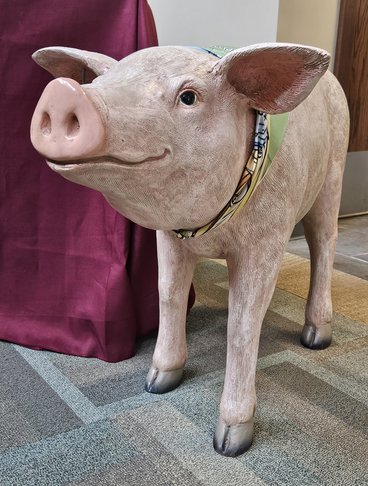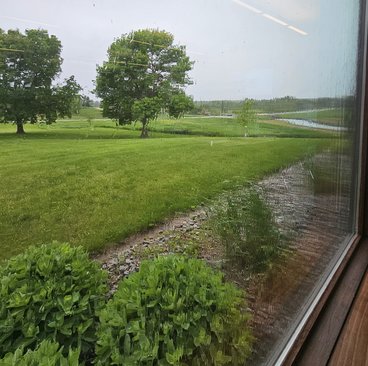On May 30th, 2024, West Central Research & Outreach Center (WCROC) hosted its second Organic Swine Field Day event to showcase some of the research being completed on alternative feed options for organic swine producers. The main focus of the event was on the ongoing project related to feeding hybrid rye to organic pigs, with experts involved in each step presenting and available to answer questions.

The event kicked off with a pulled pork lunch before Professor Yuzhi Li, who leads the organic swine program at WCROC, opened the seminar discussing how the organic swine research and facilities came to be at WCROC, as well as other ongoing organic swine-related projects. Li mentioned that the certified organic swine facilities at the WCROC is the only one across the country, and over the last seven years they have received more than $3 million in competitive grants from the Organic Research and Extension Initiative (OREI) and the Organic Transition Program (ORG) of USDA-NIFA. She was followed by Associate Professor Axel Garcia y Garcia, who researches cover cropping systems at the Southwest Research & Outreach Center, and joined the research team to discuss agronomic considerations of growing organic hybrid rye.
Two key players in the ongoing project, M.S. students Gabriella Lima and Megan Kavanagh, were also presenters at the event. Lima presented the past two years worth of data taken related to the question, “Can hybrid rye replace 50% of corn in organic swine diets without affecting pig performance?” She discussed the methodology of the study, including the steps taken to ensure similar starting points between the control groups and study groups of swine. Lima also shared the timeline for the study, from the time of diet changes (10 weeks old) to the time of harvest (~22 to 24 weeks old). Approximately every 4 weeks, objective measurements were taken related to weight gain, feed intake, and more. While the project is ongoing with final data analysis being completed this year, preliminary data demonstrates that organic swine can be fed a diet with 50% of their corn intake being replaced by hybrid rye without significant changes in feed intake or final carcass weight.
Kavanagh presented on two related topics: the effects of feeding hybrid rye on pork quality and consumer eating experience, and the profitability of a hybrid rye/pig production system. To assess the pork quality, the meat lab at the University of Minnesota St. Paul Campus processed a selected subgroup of the harvested pigs. They assessed the pork by objective measures such as pH, shear force, and color with a colorimeter. Kavanagh also used subjective measures such as color and marbling scores using scorecards developed by the National Pork Board. Additionally, a taste test was conducted at the meat lab with 73 panelists which found no significant difference between rye-fed pork and conventional pork. With these concerns addressed, the main remaining objective is to show why organic swine producers may choose to switch to a feed with hybrid rye in order to see economic benefits.

To do this, the research team calculated the cost for growing and harvesting organic winter hybrid rye based on their data collected at WCROC during the study period (2021-2023). Using information about feed and bedding usage taken over two years of the study, the researchers compared the cost of purchasing corn to feed and straw to bed organic swine to the costs of growing hybrid rye grain and straw. The preliminary results showed that – depending on market fluctuations in price – organic swine producers could see anywhere from similar costs to a savings of $20 per pig in feed and bedding cost. A large driver of that savings is seen in the cost of purchasing bedding versus growing hybrid rye to provide bedding.
Overall, the Organic Swine Field Day was a successful event, despite inclement weather canceling the outdoor tour portion of the event. There were several attendees from the swine industry and the Facebook live was viewed over 500 times with 900 reaches. The ‘Plan B’ tour included photos of the organic swine facility, recent photos taken of the organic hybrid rye fields, as well as physical examples of processed hybrid rye feed and bedding compared to regular corn feed and straw bedding. The rain turned out to be a blessing in disguise, because attendees were able to start a discussion around several topics and questions raised by the presentations. Some topics from the discussion included: the benefits and differences between growing hybrid rye for feed and bedding versus letting the straw be incorporated back into the soil for improved soil health, whether the use of different swine breed genetics would impact the profitability of hybrid rye due to many organic swine producers utilizing heritage breeds, and explaining the way that the researchers decided to formulate the feed for this study as the chosen feed formula is different than what organic swine producers have used previously.
The main takeaway from this research and this event is that hybrid rye could serve as a sustainable adjustment for organic swine producers to cut costs on feed and bedding. However, it is not as useful for an organic farmer to grow hybrid rye to sell to organic swine producers, as the cost benefits are seen in a closed loop. Research papers featuring this study are in the works, with hopes to submit to journals sometime this year
The research featured in this event would not have been possible without the project funding from the USDA-NIFA, through the Organic Research and Extension Initiative (OREI) and the Organic Transition Program (ORG). Additionally, this event was supported by the Midwest Transition to Organic Partnership Program (TOPP).

Handouts from the Organic Swine Field Day:
Evaluating different types of swine manure for hybrid rye production
Feeding hybrid rye to organic pigs
Impact of feeding hybrid rye to organic pigs on pork quality and eating experience
The economics of growing hybrid rye and feeding it to organic pigs
